|
Equity indexes were mixed in July and for the week. Investors continued to monitor events in China with its plunging stock market and slowing growth and in Greece where a new round of budget talks are underway. Investors are also keeping a close watch on U.S. economic data along with the Federal Reserve as they try to anticipate future changes in its monetary policy. Each new data release is parsed for its possible impact on the FOMC's rate decision.
On the week, investors opted to let earnings news trump economic news. As a result and despite mixed earnings reports, seven indexes in the Asia Pacific region declined while five of those tracked here advanced. However, for July, only four indexes — All Ordinaries, Nikkei, Sensex and KLCI advanced. In Europe, the DAX and IBEX retreated on the week but all indexes gained on the month. And in North America, the five indexes advanced on the week but only U.S. indexes were higher in July.
| |
|
2014 |
2015 |
% Change |
|
Index |
Dec 31 |
July 24 |
July 31 |
Week |
July |
2015 |
| Asia/Pacific |
|
|
|
|
|
|
|
| Australia |
All Ordinaries |
5388.6 |
5556.8 |
5681.7 |
2.2% |
4.2% |
5.4% |
| Japan |
Nikkei 225 |
17450.8 |
20544.5 |
20585.2 |
0.2% |
1.7% |
18.0% |
| Hong Kong |
Hang Seng |
23605.0 |
25128.5 |
24636.3 |
-2.0% |
-6.1% |
4.4% |
| S. Korea |
Kospi |
1915.6 |
2046.0 |
2030.2 |
-0.8% |
-2.1% |
6.0% |
| Singapore |
STI |
3365.2 |
3352.7 |
3202.5 |
-4.5% |
-3.5% |
-4.8% |
| China |
Shanghai Composite |
3234.7 |
4070.9 |
3663.7 |
-10.0% |
-14.3% |
13.3% |
|
|
|
|
|
|
|
|
| India |
Sensex 30 |
27499.4 |
28112.3 |
28114.6 |
0.0% |
1.2% |
2.2% |
| Indonesia |
Jakarta Composite |
5227.0 |
4856.6 |
4802.5 |
-1.1% |
-2.2% |
-8.1% |
| Malaysia |
KLCI |
1761.3 |
1720.8 |
1723.1 |
0.1% |
1.0% |
-2.2% |
| Philippines |
PSEi |
7230.6 |
7665.5 |
7550.00 |
-1.5% |
-0.2% |
4.4% |
| Taiwan |
Taiex |
9307.3 |
8767.9 |
8665.3 |
-1.2% |
-7.1% |
-6.9% |
| Thailand |
SET |
1497.7 |
1438.1 |
1440.1 |
0.1% |
-4.3% |
-3.8% |
|
|
|
|
|
|
|
|
| Europe |
|
|
|
|
|
|
|
| UK |
FTSE 100 |
6566.1 |
6579.8 |
6696.3 |
1.8% |
2.7% |
2.0% |
| France |
CAC |
4272.8 |
5057.4 |
5082.6 |
0.5% |
6.1% |
19.0% |
| Germany |
XETRA DAX |
9805.6 |
11347.5 |
11309.0 |
-0.3% |
3.3% |
15.3% |
| Italy |
FTSE MIB |
19012.0 |
23507.7 |
23538.0 |
0.1% |
4.8% |
23.8% |
| Spain |
IBEX 35 |
10279.5 |
11309.3 |
11180.7 |
-1.1% |
3.8% |
8.8% |
| Sweden |
OMX Stockholm 30 |
1464.6 |
1612.8 |
1615.6 |
0.2% |
4.8% |
10.3% |
| Switzerland |
SMI |
8983.4 |
9323.0 |
9428.2 |
1.1% |
7.4% |
5.0% |
|
|
|
|
|
|
|
|
| North America |
|
|
|
|
|
|
|
| United States |
Dow |
17823.1 |
17568.5 |
17690.5 |
0.7% |
0.4% |
-0.7% |
|
NASDAQ |
4736.1 |
5088.6 |
5128.3 |
0.8% |
2.8% |
8.3% |
|
S&P 500 |
2058.9 |
2079.7 |
2103.9 |
1.2% |
2.0% |
2.2% |
| Canada |
S&P/TSX Comp. |
14632.4 |
14186.2 |
14468.4 |
2.0% |
-0.6% |
-1.1% |
| Mexico |
Bolsa |
43145.7 |
44249.5 |
44752.9 |
1.1% |
-0.7% |
3.7% |
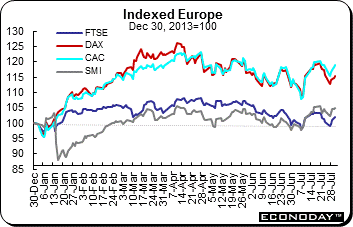 Equities rebounded from June's hefty losses in July with all indexes followed here advancing for the month. There were impressive gains in July from the SMI up (7.4 percent), the CAC (up 6.1 percent) and the MIB and OMX (up 4.8 percent). However, investors remained concerned about Chinese equities and timing of the Federal Reserve's fed funds interest rate increase. Investors also continue to follow the situation in Greece. Equities rebounded from June's hefty losses in July with all indexes followed here advancing for the month. There were impressive gains in July from the SMI up (7.4 percent), the CAC (up 6.1 percent) and the MIB and OMX (up 4.8 percent). However, investors remained concerned about Chinese equities and timing of the Federal Reserve's fed funds interest rate increase. Investors also continue to follow the situation in Greece.
For the week, however, results were mixed with the DAX down 0.3 percent and the IBEX down 1.1 percent. The FTSE was the best performer for the week, adding 1.8 percent. The driving force behind the moves continued to be European corporate earnings results. The markets fluctuated between gains and losses throughout Friday's session. In the end, enthusiasm for positive earnings results won out over pessimism caused by weak German retail sales, Eurozone unemployment and UK consumer confidence data.
Investors can look forward to the reopening of the Greek stock market. The volatility limit will be reduced to 20 percent from the current 30 percent when the bourse reopens Monday following a five week shutdown caused by the imposition of capital controls. The Athens Stock Exchange has been shut since June 29, when the government closed banks and imposed strict limits on withdrawals and foreign transfers to prevent a run on deposits by savers and companies.
Economic data were mixed this past week. Eurozone inflation remained stable at 0.2 percent in July. Unemployment in the Eurozone remained unchanged at 11.1 percent in June — the lowest rate recorded in the euro area since March 2012. German June retail sales dropped a calendar and seasonally adjusted 2.3 percent on the month after increasing 0.4 percent in May. French consumer spending increased for the third straight month in June at the fastest pace in five months, largely led by robust food consumption. Spending was up a monthly 0.4 percent. The best news came from Spain where economic growth continued to accelerate in the second quarter. Second quarter gross domestic product advanced 1 percent on the quarter after logging a 0.9 percent increase in the first quarter and 0.7 percent in the fourth quarter of 2014. This was the eighth consecutive quarterly increase.
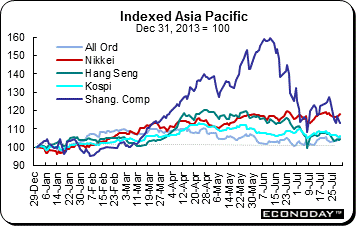 Equities were mixed in the last week of July and mostly lower for the month. For July, the All Ordinaries and the Nikkei were the two best performing Asian benchmarks in what has been an otherwise trying month. On the week, the All Ordinaries added a regional high of 2.3 percent but the Nikkei edged up only 0.2 percent. Equities were mixed in the last week of July and mostly lower for the month. For July, the All Ordinaries and the Nikkei were the two best performing Asian benchmarks in what has been an otherwise trying month. On the week, the All Ordinaries added a regional high of 2.3 percent but the Nikkei edged up only 0.2 percent.
Australian shares enjoyed a rally ahead of reporting season which begins in earnest next week. The All Ordinaries gained 4.2 percent in July and ended a four month losing streak, which was the longest since a six month slide to September 2011. The Nikkei gained 1.7 percent in July, its sixth monthly advance in the past seven. That follows June's 1.6 percent drop and the strong 5.3 percent increase in May.
At the other end of the spectrum, the Shanghai Composite lost 10.0 percent on the week and 14.3 percent in July. The last week of the month was a particularly volatile one. Monday's 8.5 percent plunge was its second biggest one day drop of the past 15 years and took a chunk out of the index's rebound that began on July 9 after authorities unveiled all those extraordinary measures to shore up market confidence. The Hang Seng was down 6.1 percent in July, its steepest decline since September last year. Down for a third straight month, the index posted its longest monthly losing streak since a four month slide to November 2008 in the depths of the financial crisis.
Chinese share prices were volatile for much of the past week with wild intraday swings as investors weighed the direction of a government intervention plan and authorities vowed to root out short sellers — or traders who bet a stock will fall — and to crack down on stock manipulation. The selloff and price swings further unnerved a market that soared early in the year, with prices peaking around mid-June. But stocks plummeted sharply in late June and early July over concerns about a bubble and investors' borrowing heavily to buy shares. After prices began to plunge, the Chinese government announced a raft of measures aimed at stabilizing prices and restoring confidence in the market. Those efforts seemed to work — but only for a while. On Monday, a broad range of stocks fell again, sending the Shanghai Composite down 8.5 percent on the day, its biggest daily drop since 2007. Almost immediately, regulators reaffirmed their commitment to stabilizing prices and said they were investigating what they called an "abnormal" stock dip. On Friday, the China Securities Regulatory Commission said it was investigating automated trading and had suspended 24 stock trading accounts for "suspected irregularities."
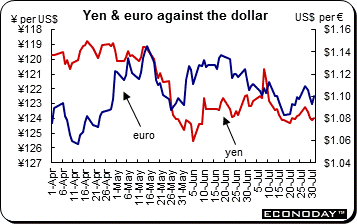 The U.S. dollar was mixed against its major counterparts last week. After strengthening each day against the euro, the dollar retreated on Friday after some disappointing economic data. The dollar was up on the week against the yen, Swiss franc and Canadian dollar but down against the euro, pound sterling and the Australian dollar. The U.S. currency had been strengthening on expectations that the Federal Reserve would increase interest rates in September. But with weak second quarter wage increases (as measured by the employment cost index) and an easing in consumer sentiment Friday, the dollar retreated. The U.S. dollar was mixed against its major counterparts last week. After strengthening each day against the euro, the dollar retreated on Friday after some disappointing economic data. The dollar was up on the week against the yen, Swiss franc and Canadian dollar but down against the euro, pound sterling and the Australian dollar. The U.S. currency had been strengthening on expectations that the Federal Reserve would increase interest rates in September. But with weak second quarter wage increases (as measured by the employment cost index) and an easing in consumer sentiment Friday, the dollar retreated.
Swiss National Bank
Switzerland's central bank posted a loss in the first half of the year after its decision to scrap a long-standing cap on the strength of the Swiss franc caused the currency to soar, eroding the value of its euro reserves. The Swiss National Bank on Friday reported a loss of 50.1 billion Swiss francs ($51.8 billion) in the six months through June 30, compared with a year earlier profit of 16 billion francs. The loss in the second quarter amounted to 20 billion francs following a first quarter loss of 30 billion francs, which was the SNB's largest since the second quarter of 2013. The deficit was almost entirely caused by declines in the value of its huge foreign currency positions which are dominated by the euro and which amounted to 47.2 billion francs. The bank also recorded a 3.2 billion franc loss on its gold holdings which are denominated in dollars.
The SNB, like most other central banks, is mandated to secure price stability and is not obliged to make a book profit. But the bank's profits are redistributed to its owners which include Switzerland's federal government and the country's 26 cantons, which are akin to U.S. states. The bank, which is publicly traded, also has private shareholders. The Swiss franc rocketed in value against the euro and other currencies in January after the SNB stunned markets by removing the cap on the franc, which had previously prevented the currency from climbing too high.
|
|
2014 |
2015 |
% Change |
|
|
Dec 31 |
July 24 |
July 31 |
Week |
2015 |
| U.S. $ per currency |
|
|
|
|
|
|
| Australia |
A$ |
0.8170 |
0.7286 |
0.731 |
0.3% |
-10.5% |
| New Zealand |
NZ$ |
0.7801 |
0.6572 |
0.660 |
0.5% |
-15.4% |
| Canada |
C$ |
0.8614 |
0.767 |
0.765 |
-0.3% |
-11.2% |
| Eurozone |
euro (€) |
1.2098 |
1.0978 |
1.099 |
0.1% |
-9.2% |
| UK |
pound sterling (£) |
1.5585 |
1.551 |
1.562 |
0.7% |
0.2% |
|
|
|
|
|
|
|
| Currency per U.S. $ |
|
|
|
|
|
|
| China |
yuan |
6.2055 |
6.2095 |
6.210 |
0.0% |
-0.1% |
| Hong Kong |
HK$* |
7.7546 |
7.7517 |
7.752 |
0.0% |
0.0% |
| India |
rupee |
63.0437 |
64.0425 |
64.136 |
-0.1% |
-1.7% |
| Japan |
yen |
119.8200 |
123.8 |
123.880 |
-0.1% |
-3.3% |
| Malaysia |
ringgit |
3.4973 |
3.8098 |
3.831 |
-0.6% |
-8.7% |
| Singapore |
Singapore $ |
1.3246 |
1.3723 |
1.372 |
0.1% |
-3.4% |
| South Korea |
won |
1090.9800 |
1167.87 |
1170.310 |
-0.2% |
-6.8% |
| Taiwan |
Taiwan $ |
31.6560 |
31.425 |
31.676 |
-0.8% |
-0.1% |
| Thailand |
baht |
32.8800 |
34.89 |
35.029 |
-0.4% |
-6.1% |
| Switzerland |
Swiss franc |
0.9942 |
0.9622 |
0.9658 |
-0.4% |
2.9% |
| *Pegged to U.S. dollar |
|
|
|
|
|
|
| Source: Bloomberg |
|
|
|
|
|
|
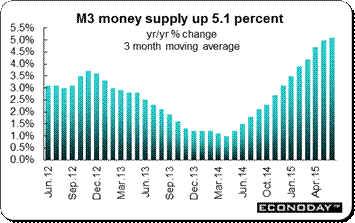 June M3 three month moving average was up 5.1 percent when compared with the same three months a year ago. Among the major counterparts, yearly growth of loans to households increased 0.3 percentage points to 1.2 percent within which borrowing for house purchase climbed 0.2 percentage points to 1.6 percent. However, lending to non-financial corporations remained negative at minus 0.1 percent, up just 0.1 percentage point from the May rate. Finally, loans to non-monetary financial corporations (excluding pension funds and insurance companies) fell from minus 0.8 percent to minus 1.4 percent. June M3 three month moving average was up 5.1 percent when compared with the same three months a year ago. Among the major counterparts, yearly growth of loans to households increased 0.3 percentage points to 1.2 percent within which borrowing for house purchase climbed 0.2 percentage points to 1.6 percent. However, lending to non-financial corporations remained negative at minus 0.1 percent, up just 0.1 percentage point from the May rate. Finally, loans to non-monetary financial corporations (excluding pension funds and insurance companies) fell from minus 0.8 percent to minus 1.4 percent.
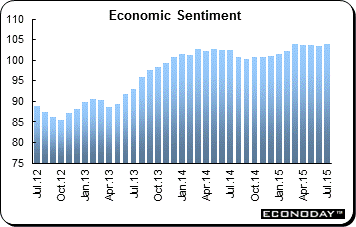 July EU Commission's economic sentiment index (ESI) signaled a modest improvement in overall confidence this month. At 104.0, the headline index was up 0.5 points from its June result, its first increase since March and its highest level since June 2011. The modest increase was largely attributable to improved sentiment in the goods producing sector (minus 2.9 after minus 3.4) and services (8.9 after 7.9). Retail (1.0 after minus 1.3) and construction (minus 23.9 after minus 24.2) also registered gains but consumer confidence (minus 7.1 after minus 5.6) deteriorated as indicated in the flash report. Among the larger four countries, the national ESI was up 0.8 points at 99.3 in France and gained 1 point to 106.0 in Germany. Spain advanced 0.3 points to 108.7 but Italy dipped 0.1 points to 106.4. Despite moving closer, France was again the only member of this group to fall short of the common 100 long-run average. July EU Commission's economic sentiment index (ESI) signaled a modest improvement in overall confidence this month. At 104.0, the headline index was up 0.5 points from its June result, its first increase since March and its highest level since June 2011. The modest increase was largely attributable to improved sentiment in the goods producing sector (minus 2.9 after minus 3.4) and services (8.9 after 7.9). Retail (1.0 after minus 1.3) and construction (minus 23.9 after minus 24.2) also registered gains but consumer confidence (minus 7.1 after minus 5.6) deteriorated as indicated in the flash report. Among the larger four countries, the national ESI was up 0.8 points at 99.3 in France and gained 1 point to 106.0 in Germany. Spain advanced 0.3 points to 108.7 but Italy dipped 0.1 points to 106.4. Despite moving closer, France was again the only member of this group to fall short of the common 100 long-run average.
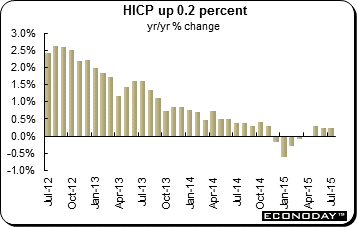 July flash harmonized index of consumer prices was unchanged at a 0.2 percent annual rate. This was the fourth month in a row that inflation has been in positive territory but, with both June and July below May's 0.3 percent peak, the trend would seem to be at best only flat. However, underlying developments were rather stronger with both core measures gaining ground at the start of the quarter. Excluding food, alcohol, tobacco and energy, prices were up 1.0 percent on the year, a couple of ticks above their final June mark. Similarly, omitting just unprocessed food and energy the annual rate gained 0.1 percentage point to 0.9 percent. The stability of the headline print masked a mixed performance among the main basket components. Thus, while yearly rates fell in energy (minus 5.6 percent from minus 5.1 percent) and food, alcohol and tobacco (0.9 percent from 1.1 percent), there were gains in both non-energy industrial goods (0.5 percent from 0.3 percent) and services (1.2 percent from 1.1 percent). July flash harmonized index of consumer prices was unchanged at a 0.2 percent annual rate. This was the fourth month in a row that inflation has been in positive territory but, with both June and July below May's 0.3 percent peak, the trend would seem to be at best only flat. However, underlying developments were rather stronger with both core measures gaining ground at the start of the quarter. Excluding food, alcohol, tobacco and energy, prices were up 1.0 percent on the year, a couple of ticks above their final June mark. Similarly, omitting just unprocessed food and energy the annual rate gained 0.1 percentage point to 0.9 percent. The stability of the headline print masked a mixed performance among the main basket components. Thus, while yearly rates fell in energy (minus 5.6 percent from minus 5.1 percent) and food, alcohol and tobacco (0.9 percent from 1.1 percent), there were gains in both non-energy industrial goods (0.5 percent from 0.3 percent) and services (1.2 percent from 1.1 percent).
 July Ifo survey overall business climate was up 0.5 points from the marginally stronger revised June reading to 108.0 for its first increase in three months. However, July's advance failed to recover all of June's 1 point loss and left the indicator within the tight 106.7 to 108.7 range seen over 2015 to date. July's modest improvement was mainly attributable to a more optimistic assessment of current conditions which climbed 0.8 points to 113.9, although this was still short of May's 114.4 mark. Expectations gained just 0.3 points to 102.4 but at least secured their first increase in four months. At sector level, sentiment was mixed with gains in wholesale (14.1 after 7.5) and manufacturing (11.3 after 10.9) contrasting with declines in construction (minus 4.5 after minus 3.7) and retail (4.0 after 5.6). The unadjusted service sector index also shed 1.5 points to 25.9. July Ifo survey overall business climate was up 0.5 points from the marginally stronger revised June reading to 108.0 for its first increase in three months. However, July's advance failed to recover all of June's 1 point loss and left the indicator within the tight 106.7 to 108.7 range seen over 2015 to date. July's modest improvement was mainly attributable to a more optimistic assessment of current conditions which climbed 0.8 points to 113.9, although this was still short of May's 114.4 mark. Expectations gained just 0.3 points to 102.4 but at least secured their first increase in four months. At sector level, sentiment was mixed with gains in wholesale (14.1 after 7.5) and manufacturing (11.3 after 10.9) contrasting with declines in construction (minus 4.5 after minus 3.7) and retail (4.0 after 5.6). The unadjusted service sector index also shed 1.5 points to 25.9.
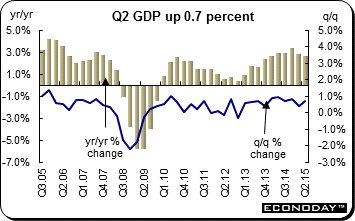 Second quarter gross domestic product expanded at a 0.7 percent quarterly rate and followed an unrevised 0.4 percent gain in the first quarter. Annual growth slipped from 2.9 percent to 2.6 percent. As usual with the preliminary figures, no details of the key GDP expenditure components were available but the output data showed solid contributions from both industrial production, which was up 1.0 percent on the quarter, and services, which matched the 0.7 percent headline gain. However, the robustness of the former masked a 0.3 percent decline in the key manufacturing sector (after a minimal 0.1 percent first quarter rise) and reflected instead a 7.8 percent surge in the volatile mining & quarrying subsector, possibly in part due to recent tax changes announced in the March Budget. The quarterly advance in services was predicated upon solid increases in distribution, hotels & catering (0.9 percent), transport, storage & communication (0.8 percent) and business services & finance (also 0.8 percent). Government was up 0.2 percent. Elsewhere construction was only flat and agriculture declined 0.7 percent. Second quarter gross domestic product expanded at a 0.7 percent quarterly rate and followed an unrevised 0.4 percent gain in the first quarter. Annual growth slipped from 2.9 percent to 2.6 percent. As usual with the preliminary figures, no details of the key GDP expenditure components were available but the output data showed solid contributions from both industrial production, which was up 1.0 percent on the quarter, and services, which matched the 0.7 percent headline gain. However, the robustness of the former masked a 0.3 percent decline in the key manufacturing sector (after a minimal 0.1 percent first quarter rise) and reflected instead a 7.8 percent surge in the volatile mining & quarrying subsector, possibly in part due to recent tax changes announced in the March Budget. The quarterly advance in services was predicated upon solid increases in distribution, hotels & catering (0.9 percent), transport, storage & communication (0.8 percent) and business services & finance (also 0.8 percent). Government was up 0.2 percent. Elsewhere construction was only flat and agriculture declined 0.7 percent.
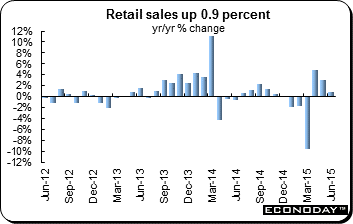 Sales increased for a third consecutive month. June retail sales were up 0.9 percent on the year. Sales were not as robust as they were in the prior two months with May increasing 3.0 percent and April, 4.9 percent. Four subindexes increased while four declined. Auto sales were up for a third month, this time increasing 8.0 percent. Food & beverage sales were also up for a third month. They increased 3.1 percent. Machinery sales, however, slid 3.9 percent after increases of 8.8 percent in May and 11.1 percent in April. Fuel sales were down for the ninth straight month, dropping 10.7 percent in June. Sales increased for a third consecutive month. June retail sales were up 0.9 percent on the year. Sales were not as robust as they were in the prior two months with May increasing 3.0 percent and April, 4.9 percent. Four subindexes increased while four declined. Auto sales were up for a third month, this time increasing 8.0 percent. Food & beverage sales were also up for a third month. They increased 3.1 percent. Machinery sales, however, slid 3.9 percent after increases of 8.8 percent in May and 11.1 percent in April. Fuel sales were down for the ninth straight month, dropping 10.7 percent in June.
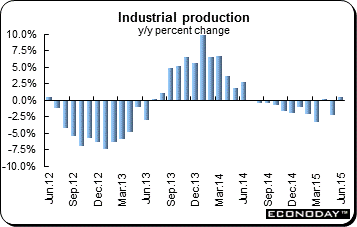 June industrial production increased a greater than expected 0.8 percent on the month after sinking 2.1 percent in May. From a year ago, output improved to an increase of 0.4 percent after declining 2.3 percent in May. Among the industries that contributed to the increase were transport equipment (up 2.4 percent), chemicals except drugs (up 2.8 percent) and plastic products (up 3.6 percent). In May, all three of these industries declined. Slightly less encouraging was that much of the monthly gain came from 1.3 percent growth in inventories after a 0.8 percent decline in May. Shipments were up 0.3 percent, rebounding from a 1.9 percent drop the previous month. June industrial production increased a greater than expected 0.8 percent on the month after sinking 2.1 percent in May. From a year ago, output improved to an increase of 0.4 percent after declining 2.3 percent in May. Among the industries that contributed to the increase were transport equipment (up 2.4 percent), chemicals except drugs (up 2.8 percent) and plastic products (up 3.6 percent). In May, all three of these industries declined. Slightly less encouraging was that much of the monthly gain came from 1.3 percent growth in inventories after a 0.8 percent decline in May. Shipments were up 0.3 percent, rebounding from a 1.9 percent drop the previous month.
 June national consumer prices were virtually unchanged as Japan continues to struggle with deflation. All items CPI was down 0.2 percent on the month but up 0.4 percent on the year. Excluding fresh food, the CPI was unchanged on the month and inched up 0.1 percent from a year ago. The CPI excluding food and energy was unchanged on the month and up 0.6 percent from a year ago. Energy costs continue to weigh on the index, dropping 7.0 percent on the year after declining 6.0 percent in May. However TVs were up 3.3 percent after slipping 0.1 percent in May. Electronics were up 0.4 percent after declining 1.7 percent the month before. June national consumer prices were virtually unchanged as Japan continues to struggle with deflation. All items CPI was down 0.2 percent on the month but up 0.4 percent on the year. Excluding fresh food, the CPI was unchanged on the month and inched up 0.1 percent from a year ago. The CPI excluding food and energy was unchanged on the month and up 0.6 percent from a year ago. Energy costs continue to weigh on the index, dropping 7.0 percent on the year after declining 6.0 percent in May. However TVs were up 3.3 percent after slipping 0.1 percent in May. Electronics were up 0.4 percent after declining 1.7 percent the month before.
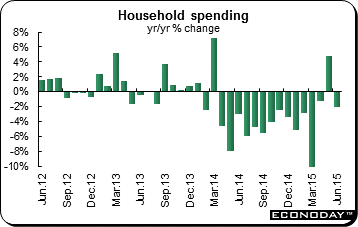 June household spending surprised and dropped 2.0 percent on the year. Analysts expected an increase of 1.4 percent. The decline in spending followed a 4.8 percent bounce in May. Prior to the May reading, spending had declined for 13 consecutive months. Spending on clothing and footwear tumbled 13.3 percent on the year. Expenditures on housing declined 4.1 percent and culture & recreation saw a 1.9 percent drop. Education spending jumped 9.4 percent on the year and transportation & communication expenditures were 1.1 percent higher. June household spending surprised and dropped 2.0 percent on the year. Analysts expected an increase of 1.4 percent. The decline in spending followed a 4.8 percent bounce in May. Prior to the May reading, spending had declined for 13 consecutive months. Spending on clothing and footwear tumbled 13.3 percent on the year. Expenditures on housing declined 4.1 percent and culture & recreation saw a 1.9 percent drop. Education spending jumped 9.4 percent on the year and transportation & communication expenditures were 1.1 percent higher.
The Federal Reserve kept its monetary policy unchanged but upgraded its outlook on the U.S. economy. Analysts continue to parse each data release for its impact on the Fed's decision making process on rates. Economic data in Japan were mixed with June data for prices, consumer spending and unemployment remaining soft. While there were several positive releases of economic data in Europe and the UK, Germany's disappointing unemployment and retail sales data weighed on investors.
The Bank of England will for the first time release a slew of key reports alongside its monthly monetary policy decision on Thursday, meaning investors and the public will have to contend with a flood of information usually released separately. At 1100 GMT (1200 BST) on August 6, the BoE will simultaneously publish its monthly decision on interest rates, the breakdown of how its policymakers voted along with a summary of their debate and its quarterly forecasts for Britain's economy, including inflation. Governor Mark Carney will then hold a news conference at 1145 GMT. The Reserve Banks of Australia and India and the Bank of Japan also meet during the week.
| Central Bank activities |
|
| August 4 |
Australia |
Reserve Bank of Australia Monetary Policy Meeting |
|
India |
Reserve Bank of India Monetary Policy Meeting |
| August 6 |
UK |
Bank of England Monetary Policy Meeting & Minutes |
|
|
Bank of England Quarterly Inflation Report |
| August 6,7 |
Japan |
Bank of Japan Monetary Policy Meeting |
| |
|
|
| The following indicators will be released this week... |
| Europe |
|
|
| August 3 |
Eurozone |
Manufacturing PMI (July) |
|
Germany |
Manufacturing PMI (July) |
|
France |
Manufacturing PMI (July) |
|
UK |
Manufacturing PMI (July) |
| August 4 |
Eurozone |
Producer Price Index (June) |
| August 5 |
Eurozone |
Services & Composite PMI (July) |
|
|
Retail Sales (June) |
|
Germany |
Services & Composite PMI (July) |
|
France |
Services & Composite PMI (July) |
|
UK |
Services PMI (July) |
| August 6 |
Germany |
Manufacturing Orders (April) |
|
UK |
Industrial Production (June) |
| August 7 |
Germany |
Merchandise Trade (June) |
|
France |
Merchandise Trade (June) |
|
|
Industrial Production (June) |
|
UK |
Merchandise Trade (June) |
| |
|
|
| Asia/Pacific |
|
|
| August 3 |
China |
Manufacturing PMI (July) |
|
India |
Manufacturing PMI (July) |
|
Japan |
Manufacturing PMI (July) |
| August 4 |
Australia |
Retail Sales (June) |
|
|
Merchandise Trade (June) |
| August 6 |
Australia |
Labour Force Survey (July) |
| |
|
|
| Americas |
|
|
| August 5 |
Canada |
International Trade (June) |
| August 7 |
Canada |
Labour Force Survey (July) |
Anne D Picker is the author of International Economic Indicators and Central Banks.
|

